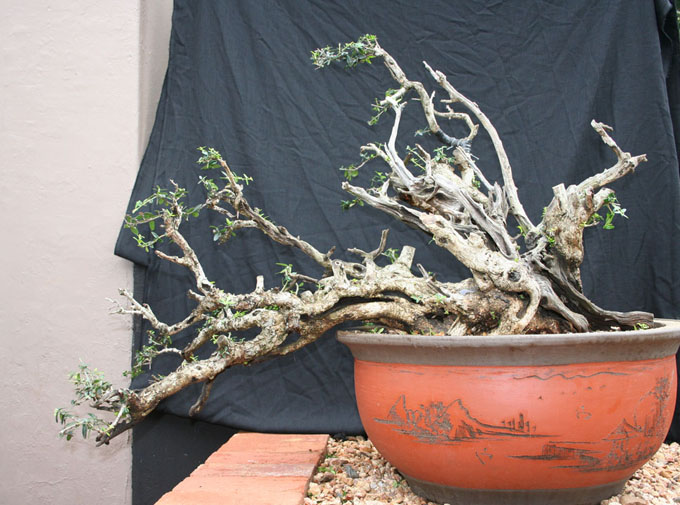 After. Robert Steven’s simulation of an Olive that was submitted by Gary Howes. There’s a lot to like about this simulation, including just how natural and untamed it looks (even the pot has an untamed quality); untamed in the sense of something that has managed to stay alive and even thrive under some of the harshest conditions that Nature can dish out.
After. Robert Steven’s simulation of an Olive that was submitted by Gary Howes. There’s a lot to like about this simulation, including just how natural and untamed it looks (even the pot has an untamed quality); untamed in the sense of something that has managed to stay alive and even thrive under some of the harshest conditions that Nature can dish out.
Living on the cutting edge. It has been a while since we’ve featured a critique by Robert Steven. If you are new to Bonsai Bark, Robert is one of the world’s best known bonsai artists, whose renown has a lot to do with how he has managed to live on the cutting edge (so to speak) of bonsai design for a long time now. In addition to being a famous bonsai artist, Robert is also one of world’s leading bonsai experts (you could even say bonsai scholars) and the author of two benchmark bonsai books.
 Before. This is the photo that Gary submitted to Robert.
Before. This is the photo that Gary submitted to Robert.
Robert’s critique
Needless to say, this bonsai has outstanding features, especially the deadwood. Our task is to explore and express these features in a way that conveys a life story of a tree in nature; where it grows, how the deadwood is formed and how it is transformed from its original shape.
To do this, the design elements, the deadwood, the living trunk and branches, the foliage and the container, should all be composed in a way that creates a sense of consistency and unity.
I am sure the artist has the idea, but I am not so sure that he has a concrete blueprint of the design; for example the shape of the crown. Look at the shoots that are on the tips of the branches. If these are used to form the foliage pads, they will be too high (too far separated from the rest of the tree). If this is the case, then the overall composition will be leggy and less compact than is desirable.
Furthermore, although the deadwood is very nice, it should not take over the main object, which is the living tree. Instead, the deadwood is there to emphasize and enhance the tree’s character and its life story.
In this case, the deadwood is too busy. It needs to be reduced and simplified. Last but not least is the pot. Neither its size, shape nor color fit the design of the tree. The size is too big, the shape and the color are too feminine for the massive character of the tree.
My simulation with my solution is at the top of the post…
The existing deadwood is reduced, some branches are shortened and the end of the main branch is turned into deadwood. The ramification (branching) is restructured to be more compact but spare with more empty spaces. Then a smaller dark color container is used to enhance the overall effect. I believe the final result conveys a more natural transformation.
Robert’s general comments
There is more than one way to design any bonsai and my critiques and recommended solutions might not always fit your taste and personal preferences, but I always try to give my opinion based on artistic and horticultural principles.
To understand my concepts better, please read my books Vision of My Soul and Mission of Transformation which are available at Stone Lantern.
My new bonsai blog address : http://robert-steven.ofbonsai.org
Facebook : www.facebook.com/robertbonsai
 Point well taken. Robert sent this photo along with his critique.
Point well taken. Robert sent this photo along with his critique.
I am not an bonsai artist or owner…but appreciate them..I totally agree about the pot…..a simulation is how the tree ought to look? and how is this done by photo enhancement?
The transformation is spot on. In fairness to the artist though it seems the tree is very early in its development. I think if the artist let the tree grow in a bit the original submission would probably look much better. The references to the balance between the deadwood and living branches could also have been addressed by letting the the tree grow out from the lower branches. I am so envious of Robert’s access to santigi. His redesign is so reminiscent of santigi trees that he has designed . The pot selection is perfect. Great job Robert, once again.
Thanks Owen. Yes, Robert and his Santigi (Pemphis acidula) are famous.
Hi Sharon,
Robert’s simulations are his suggestions about how particular trees might look with enough time and some skill thrown in. You’ll have to ask Robert about just how he goes about doing them.